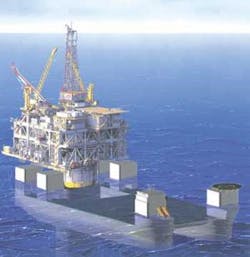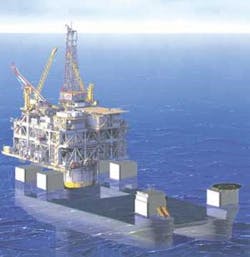Multi-purpose catamaran designed for deepwater heavy-lift market
Addressing the need for lifting vessels that can effectively serve the challenging deepwater market, Huisman-Itrec, based in The Netherlands, has developed a multi-purpose vessel that can transport loads up to 100,000 metric tons on its 13,800-sq-m main deck, lift and install 25,000-ton topsides, and remove 10,000-ton jackets without extra tools or modifications. The 196-m multi-purpose cata-maran (MPC), with the Huisman-Itrec A-frame installed, can lift 7,500- ton modules over a height of 150 m.
Primarily designed for the demanding conditions of deepwater work, the vessel is also suited for shallow-draft areas such as the North Sea. Recognizing that installation and decommissioning of drilling platforms does not account for 100% of the commercial available working time of the vessel, Huisman-Itrec designed the catamaran to handle other tasks, as well, and to work around the globe with minimal weather downtime.
The vessel has completed the concept phase and begun detailed engineering. Extensive model testing and simulations have confirmed the feasibility of the concept. The unit's workability during topside installation on spars has been estimated at:
- North Sea >88%
- West Africa >96%
- Brazil >91%
- Gulf of Mexico >96%.
The MPC is built in the form of a large semisubmersible catamaran with two hulls, two deckhouses, four multi-purpose lifting towers, and a connecting deck box. The deck box stops well ahead of the stern, creating a U shape at the aft end of the vessel. The design is not centered on a "brute force" approach used by many competitive designs, but instead uses a smart combination of the natural available resources to lower the demands on the lifting equipment to technically feasible levels. The MPC is fitted with two engine rooms and will be certified to dynamic positioning class III. When used as heavy lift transport vessel, the large deck can be used in combination with the proven float-on/float-off method. Loads with a maximum draught of 16 m with a weight of 100,000 tons can be loaded on the vessel with minimum effort.
When used as a topside installation vessel, the topsides are supported on the four movable multi-purpose lifting towers (MPLT) located at the aft end of the vessel. Each MPLT provides space for three winches, which can operate when the vessel is submerged. Once the MPC with the topside arrives at the location of the Spar or other floating structure, the winches of the MPLTs connect to the floating structure. After connection, the MPC submerges. When the MPC is submerged, the winches control the motions of the MPC and the Spar such that the motions of both vessels are synchronized. By using the small water piercing surface when submerged in combination with a large mass, including the effects of added mass, the resulting forces needed to synchronize the motions of the MPC and Spar are relatively small.
Wave induced motions and forces lie well within feasible levels, as is reflected in the high workability figures. After synchronization of both vessels, the MPC submerges deeper, and without excessive contact forces, the topside is placed on the Spar.
Because the MPC does not have to connect to the sea bottom to stabilize the motions, it can install topsides and modules in unlimited water depths. The MPC uses a combination of DP and connection wires to synchronize the horizontal motions, thus alleviating the need for additional suppliers or support ships to lay out anchor patterns or suction piles. The MPC can make use of suction anchors when the need arises.
For jacket removal, the winches of the MPLTs are connected to the jacket and used in lifting mode. When not in its primary role as installation/decommissioning vessel, the catamaran can very effectively be used as deepwater installation vessel or very heavy load semisubmersible transport vessel. Deep- water installation capabilities include 2,000-ton capacity at 1,500-m water depth and 700-ton capacity at 3,000-m water depth.




